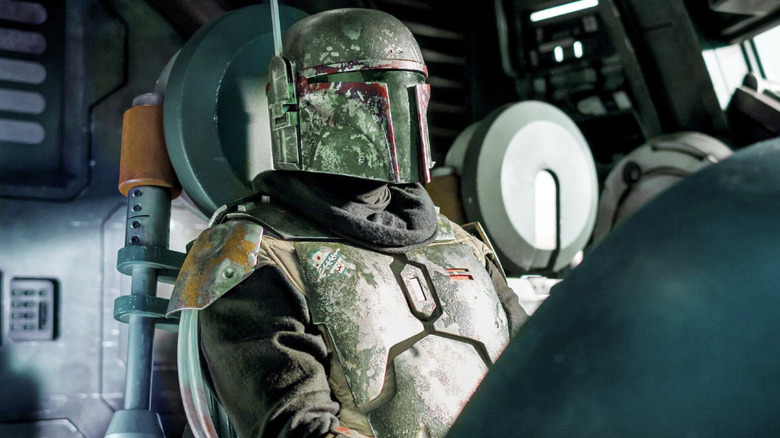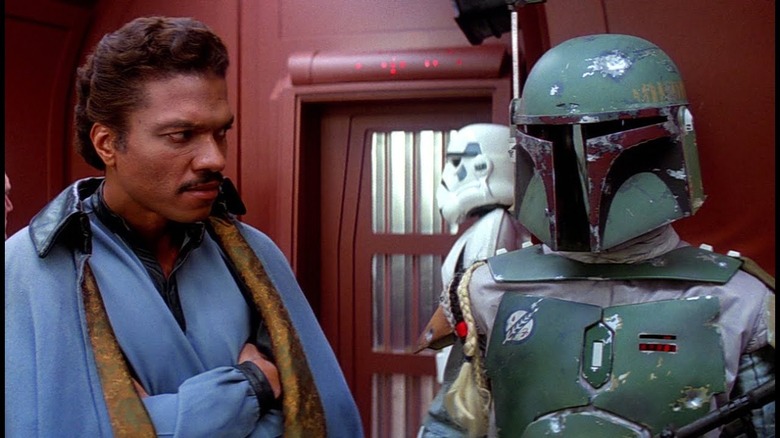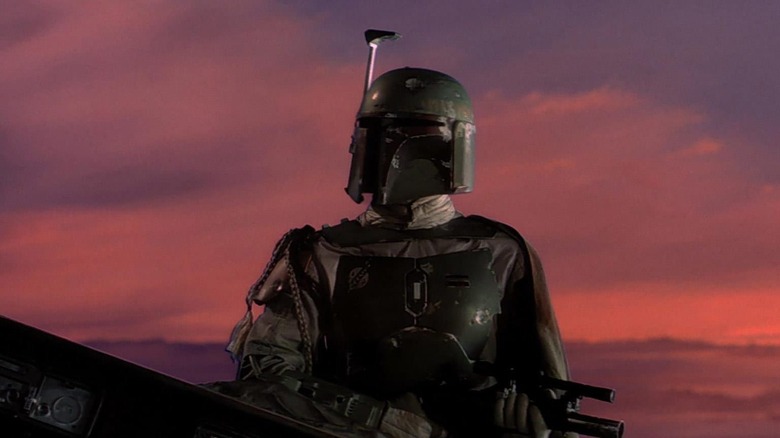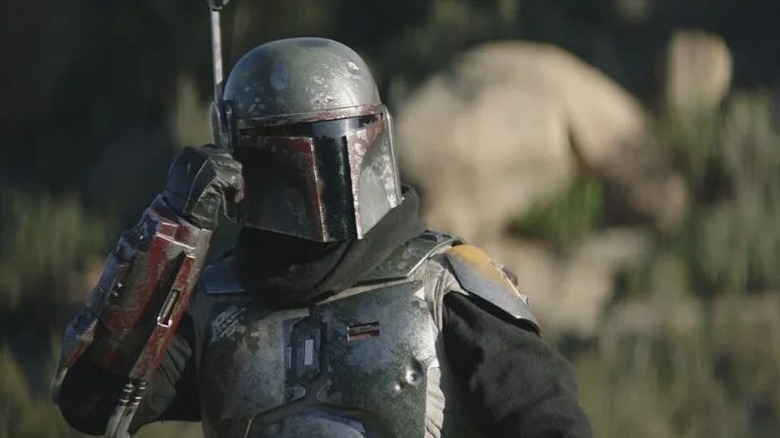Star Wars' Famous Mandalorian Armor Wasn't Always Meant For Boba Fett
When "Star Wars Episode V: The Empire Strikes Back" was first released in theaters in 1980, fans were enraptured by the unique "look" of a certain background bounty hunter so much that he quickly elevated to fan favorite status. Not much was known about Boba Fett at the time — his backstory would later be colored by expanded universe material and a parentage established by the "Star Wars" prequel trilogy. His design, however, was still compelling enough to capture the imagination of the most curious-minded fans of George Lucas's fantasy/sci-fi galaxy.
It's the sleek and effortless cool of the T-shaped visor on the helmet, the various intricate shapes that make up his weaponry and toolset, a dark green and black color palette, and even a jetpack that transformed into every kid's most desired action figure. With all this in mind, it may come as a shock to know that the classic Mandalorian-style armor design that Boba Fett wears wasn't always meant to be for the mysterious bounty hunter.
For the 40th anniversary of "The Empire Strikes Back," StarWars.com published an interview with Joe Johnston, the visual effects art director who worked on the beloved sequel, asking about the creation of Boba Fett's character design, which had a surprisingly unlikely origin story.
'There was going to be 40,000 of these guys.'
"George [Lucas] wanted a new trooper," Joe Johnston told StarWars.com. "The original idea behind Boba Fett was that he was going to be an army of super troopers. There was going to be 40,000 of these guys." Johnston worked closely with another titan of his craft, concept artist Ralph McQuarrie, on the initial prototype armor for a new stormtrooper; however, producer Gary Kurtz was mindful of their budget goals, and unfortunately, the "super trooper" design was left behind on the cutting room floor. Later, Lucas found another chance to repurpose the design later in the film and figured out a character with enough edge to match the rough edges.
"The outfit came back from the UK [production office] and George said, 'Instead of an army of super troopers, this is going to be a war bounty hunter,” Johnston shared. From then on, born from the prototype, Lucas workshopped the idea of Boba Fett's character and backstory:
"'He's sort of a bad guy but he's not on the Empire's side and he's not on the rebels' side. He's like a free agent, and he goes around the galaxy arresting people and bringing them back to justice or bringing them back to Jabba the Hutt or whoever. He's a mercenary. He'll do anything for money, and his outfit, the way he looks, should reflect that.'"
Johnston and McQuarrie were a dream team
Together, Joe Johnston and Ralph McQuarrie continued to collaborate, driven by Lucas's rough outline of Boba Fett's personality. Though the pair had very different skill sets, that ultimately proved to be much more helpful in the long run. Here's what Johnston had to say to StarWars.com:
"Ralph and I designed the outfit in the same way that we designed everything else, which was that we'd trade designs back and forth. Ralph and I worked really well together because I was a better designer than I was an illustrator, and Ralph was a better illustrator than he was a designer. He was still a great designer, and I could sort of render things — I could sort of describe the shape in an illustration. But I was like a sketch artist and he was like the finished renderer. [...] So, in the process of trading things back and forth, the design would change more with me, and then he would illustrate it [like] how it was going to look. It was a great way to work."
With an explicit goal of designing the costume for a specific character, Johnston and McQuarrie were now tasked with adding details to make the armor stand out. When the prototype suit arrived, it left a lot to be desired "So, the original suit came back and it was all white," Johnston said. "Everything about it was white. The jumpsuit underneath was white, and all the panels and the helmet were white, with accents of aluminum. [Lucas] said, 'It's not going to be this. Take it and paint it up.'" Consistent with the scrappy, rustic aesthetic of "Star Wars," Lucas felt Boba Fett's armor should appear extremely worn — like it had been through many battles — "as if Fett had acquired pieces from different places and put it together himself."
A design that stood the test of time
"At that point, I took it over to the [Industrial Light & Magic] facility on Kerner [Boulevard], and I laid everything out on the floor." Joe Johnston told StarWars.com. "I went down to the hobby shop in San Anselmo and I bought this brand of paint called Floquil. It was mostly used for model railroading. I bought just dozens of jars of this stuff, as many colors as I wanted. I put them in airbrushes and I start painting this thing."
There was only one suit in production, so Johnston ended up painting over it continuously until he was satisfied with the color, but this also helped make the armor have the aged and dented feel that he was looking for. Green paint over silver coats with some scratched-off layers allowed texture and personality, mimicking damaged and bent metal. As a reference to the Western roots of the "Star Wars" franchise, there was even going to be a poncho resembling Clint Eastwood's look in "A Fistful of Dollars," but Johnston decided to scrap it emphasizing functionality over style.
This resulted in ultimately not just one of the more distinct and recognizable armored characters in "Star Wars," but a design that would serve as the basis of so many other different Mandalorian characters within the franchise. Boba Fett graduated from a background character to a significant part of lore thanks to "Attack of the Clones," and the character became a cosplay favorite for decades.
Outside of "Star Wars," Joe Johnston, would go on to direct his own feature films, like "Honey, I Shrunk the Kids," "The Rocketeer," and even "Captain America: The First Avenger."



